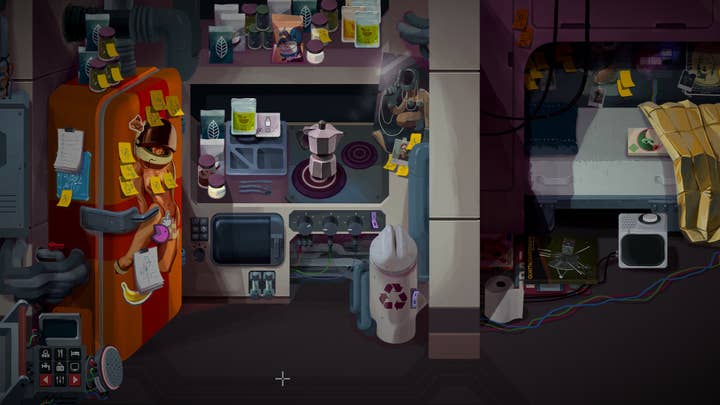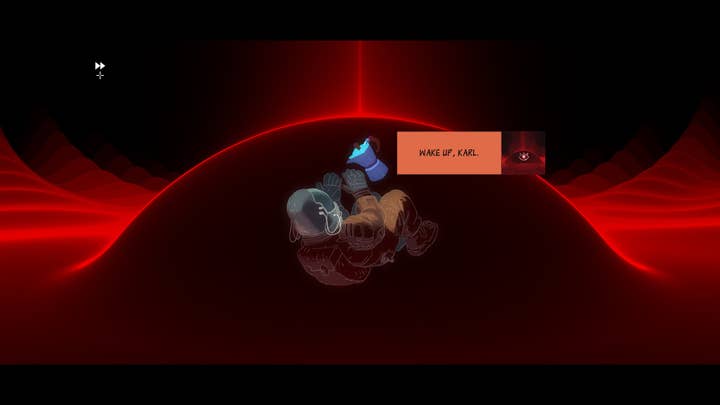Still There examines how far one can run from grief | Why I Love
Chad Briggs offers a narrative analysis of GhostShark's tale of a deep space lighthouse keeper working through loss
Why I Love is a series of guest editorials on GamesIndustry.biz intended to showcase the ways in which game developers appreciate each other's work. This entry was submitted by Chad Briggs of Element X, a studio that produces award winning animation and interactive AR/VR experiences.
Everybody runs. We suffer heartbreaking loss, then we run from it. We suppress it. We bury it. We try all the easy, quick Band-Aids one can muster to return to a life of normalcy without confrontation. We seek the comfort of tangible things that we can grasp and make sense of. But if our nature is to run far away from reconciling the death of a loved one, then the inevitable question posed by the game Still There is: How far is far enough?
I stumbled upon Still There while watching virtual panels at LudoNarraCon 2020 on Steam. There was an ad for the game plastered somewhere in the mix of all the sponsor banners that caught my eye. The game initially drew me in with screenshots of lush, hand-painted graphics tinged with neon-flavored analog glows. This art style would be but one of the many layers of future-past tech vibes I'd find in the game. Ever the jaded pessimist, I proceeded to download the game demo expecting a mildly entertaining narrative and maybe a few fun, nerdy puzzles if I was lucky.
Instead, I got a game that continually surprised me with its poignant narrative depth and clever mechanics. Still There is a fantastic point-and-click adventure game that immerses the player in the isolation and daily grind of running a decaying space lighthouse, all as a mechanism to avoid coping with the lingering trauma of a tragic loss.
Still There's gameplay is confined to one room, with a dash of hidden objects and electrical engineering puzzles thrown into the mix. The player is only allowed to scroll left and right on the screen, panning around the station. This serves as the base navigation mechanic for the entire game, along with cutscenes allowing dialogue-only interaction when the player character is dreaming or in an altered mental state. The unique visuals of the game, along with the intuitive interface and rewarding engineering puzzles, keep the fun level high and make the player want to spend time in this world.
The developers attempt to tackle a fascinating challenge: How to best serve the player the struggle of working through loss and grief if the player hasn't personally experienced the tragedy?
The game manages to firmly anchor us in this experiential grieving process by relying on two components: Letting the gameplay enable the player character's self-neglect, and supporting characters who show us the way past those veils of denial.
The puzzles created by the gameplay are often mundane, served up as daily maintenance at the bequest of the faceless, monolithic corporation that owns the lighthouse. The tasks are comforting and familiar because we've done the domestic variations ourselves: washing dishes to forget about an argument with a spouse or working on home projects to avoid the realities of a recent layoff. Much like their real-life counterparts, these game mechanics distract our minds with repetition and routine, allowing it no room to drift towards more taxing existential problems that loom nearby.

Uncovering the player character's suppressed despair isn't the real trick of the game's character development. The real trick is in the dialogue choices that enable the player character, and by extension the player themselves, to realize that meaningful human connections help us navigate through the emotional brambles surrounding a personal loss. That same lesson is learned alongside another hard one as the characters we grow attached to throughout the game are placed in peril: The salve of new human connections always comes with the risk of additional loss and trauma.
The only playable character game is the faceless protagonist, Karl Hamba. We play the game looking through his eyes as we observe our cramped, utilitarian living space at the edge of the galaxy. The game makes it clear from the opening act that Karl is in heavy denial as he dreams of his estranged ex-wife, Hani. He floats aimlessly in an abstract void as her voice implores for him to "wake up and smell the coffee."
The game's cast of non-playable characters are written with a lot of love, lathering rich layers of meaning into the game's story
The conversation reveals two key pieces of information. First, they have lost their daughter in a manner yet unknown and Karl does not know where she is. Second, Hani point-blank asks Karl, "How are you Karl?" The two dialogue responses are "I'm okay." and "I'm not okay." Even if the player attempts to choose "I'm not okay.", the game forces the cursor over to "I'm okay," illustrating just how deep denial runs in Karl's psyche. This gameplay mechanic serves as a remarkable simulation for the player to experience the powerlessness of rational thought against a mind mired in denial and depression.
The game's cast of non-playable characters are written with a lot of love, lathering rich layers of meaning into the game's story. As the day-to-day life of maintaining the space station tempts us with false inner peace, the NPCs beckon us forward to become whole again. To drive home the isolation theme, there are no physical characters present in the game, save for the ship's onboard AI named Gorky and your pet lizard. These two are the first major and minor NPC's we meet, with Gorky helping manage and run the space lighthouse known as the Bento. Gorky is far more than the station's sassy Alexa, however. The writers dangle you on both sides of whether Gorky is truly sentient, or merely some sort of advanced chatbot wearing a low-rez, monochrome face made of emojis.
These narrative bread crumbs create natural curiosity that drives the players interactions with him. At one point the player can ask Gorky "Do you have a soul?" and Gorky deflects with a hilarious emoji and verbal response: "What kind of creepy ass question is that?" Not exactly a yes, but not exactly a no.
The other NPCs you meet through external audio communications and dreams are equally effective. When Karl dreams of speaking to Hani in his troubled attempts at sleep, she becomes the more vocal guiding light for him to move forward throughout the game. The guiding light comparison becomes quite literal, as during the dream sequences Karl starts to envision a diamond shaped glow that seems to be the source of the voices he's interacting with.
The player can also uncover a handful of scattered sentimental items such as a photo or a mug. Interacting with them will prompt inner dialogue about Karl's dead daughter Eshe. Karl's ruminating on these items lets the player experience how someone in denial surrounds themselves with keepsakes of grief, giving them an excuse to wallow in the pain. These items are artifacts from many years prior, ultimately serving up Eshe as a metaphor for the past.

If Eshe is a metaphor for the past, then Elle certainly becomes a metaphor for the future and what could have been. We are introduced to Elle via a distress broadcast as a technician onboard the Corona, a stranded transport ship. As Karl and Elle's relationship develops, personal tidbits spark paternal embers in Karl, who in a Freudian slip at one point calls her "Eshe."
We share Karl's growing hope, whether delusional or not, that he has been given a second chance to save his daughter. This hope is never explicitly stated, which makes the game's success at making you feel it even more impressive
Gameplay segments that hang Elle's life in the balance are some of Still There's more fully realized experiences, enabling the player to truly live in Karl's skin. We share his growing hope, whether delusional or not, that he has been given a second chance to save his daughter. This hope is never explicitly stated, which makes the game's success at making you feel it even more impressive.
One character in the game has no human qualities or speaking roles at all, but still looms large as subtext for the entire game. That character is the Bento itself. The art direction and general appearance of the Bento is visualized as something that is crammed together from a considerable amount of analog, old-school-looking tech. The player uses a modem to communicate, a periscope to view the stars outside, and configures remote computers using a MIDI keyboard. Consequently, this old technology is breaking down and in constant need of repair, only to be cobbled back to minimum functioning level, never improved. This mirrors Karl's own condition and his bare minimum mental health maintenance at the start of the game.
Additionally, the space lighthouse's very purpose plays a key role. Its function is similar to that of the lighthouses of old that dotted shorelines on Earth. Passing ships will ping nearby space lighthouses, triangulating their position from the pings, in hopes of arriving safely at their ultimate destination. At the start of the game Karl is adrift, alone and grieving internally. By the end of the game Karl has used the Bento for its original purpose: Letting it help guide him on his way through grief by communicating with Elle and others. Other supporting characters like Salvatore, Grey Di Maggio, and Deirdre Janavic round out the NPC's to represent and reflect additional issues in Karl's soul.
By the end of the player's experience in the Bento, Still There admirably succeeds in what it set out to do: Letting us step into the shoes of a man who realizes running from his past is no longer an option. The game not only uses surprising, clever mechanics to illustrate the protagonist's personal issues, but also pulls off the feat of making the player feel like an actual engineer. Picking up the instruction manual and solving problems with ingenuity and elbow grease has never been as much fun. It is an astounding, truly moving journey and a thoughtful examination of how we deny lingering grief, how we find closure, and how we move forward again.
For a longer, more in-depth analysis of the game, you can check out http://www.chadbriggs.com.
Developers interested in contributing their own Why I Love column are encouraged to reach out to us at news@gamesindustry.biz.

